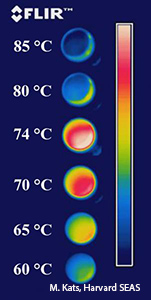
Infrared camera images of the 1-cm-diameter sample for increasing temperatures.
Wherever people celebrate Halloween, they disguise themselves with masks and costumes. Likewise, researchers have discovered a ceramic coating that, at certain temperatures, tricks infrared cameras by appearing cooler than it really is.
Scientists in OSA Fellow Federico Capasso's group at Harvard University (U.S.A.) tested the thermal emittance profile of a thin film of vanadium dioxide layered on a sapphire substrate. When heated, the ceramic gives off increasing amounts of infrared radiation until it reaches a transition temperature where it begins to display “large negative differential thermal emittance” (Phys. Rev. X 3, 041004).
Vanadium dioxide is a thermochromic material; its optical properties depend on temperature, like a “mood ring” from the 1970s. At room temperature, the material loses its insulating ability and begins to act like an electrical conductor. Scientists have known about this insulator-metal transition for decades, but bulk crystals of the material often cracked from the stress of the transition.
Capasso and colleagues, including graduate student Mikhail Kats and associate professor Shriram Ramanathan, grew a 150-nm-thick epitaxial layer of vanadium dioxide over a sapphire substrate. Using Fourier-transform infrared spectroscopy, they checked its thermal emissivity over the range of 40 to 100 ºC. For comparison, they took similar measurements of a soot-covered silicon wafer.
Between 40 and 74 ºC, the vanadium dioxide behaved like most materials: it gave off more infrared radiation as it got hotter. However, at higher temperatures, the film camouflaged itself: at 80 ºC it emitted only as much infrared light as it did at 60 ºC, and even less than that at 85 ºC. Scientists can reverse and repeat the effect at will.
The Harvard researchers envision a number of potential applications for the vanadium dioxide film, including thermal camouflage for military vehicles operating at night. Engineers could also build an infrared blackboard that uses heating or cooling sources to “write” a message onto a vanadium dioxide film near the transition temperature; only people with infrared cameras or night-vision goggles would be able to read the inscription.
